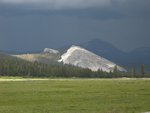After completing an analysis of the flat-tailed horned lizard’s conservation status, the U.S. Fish and Wildlife Service announced today the species does not need protection under the Endangered Species Act (ESA).
This determination was made because threats to the species as identified in the 1993 proposed rule are not as significant as earlier believed and available data do not indicate the species is likely to become endangered in the foreseeable future throughout all or a significant portion of its range.
Threats identified in the 1993 proposed rule included loss and degradation of habitat from agricultural and urban development, OHV use, geothermal energy development, sand and gravel mining, military training activities, and construction of roads and utility corridors, and gold mining.
In 1997 an Inter-Agency Cooperative Agreement between Federal and State agencies in California and Arizona was signed, and the agencies developed a Rangewide Mangement Strategy to address conservation of the lizard. The Service subsequently withdrew the proposed listing rule in 1997. Since that time the withdrawal has been challenged several times.
Following the most recent challenge to the Service’s determination that the lizard did not need the protection of the Act, a comprehensive review of the species’ status was initiated in 2009. Currently, about 457,457 acres of flat-tailed horned lizard habitat is managed by signatories to the Inter-Agency Cooperative Agreement. These lands are divided into five Management Areas (MAs) – the Borrego Badlands, West Mesa, the Yuha Desert, East Mesa, and the Yuma Desert. Additionally, the Ocotillo Wells State Vehicular Recreation Area is a designated research area.
The MAs include core areas to maintain self-sustaining populations of the lizard in the U.S. Although the Coachella Valley population of the lizard is outside of any MA, conservation of that population is being addressed under the Coachella Valley Multiple Species Habitat Conservation Plan (Coachella Valley MSHCP).
In reviewing the threats to the species identified in 1993, and any newly identified potential threats, the Service determined habitat loss and degradation largely occurred in the historical past. Although urban development is expected to continue in portions of the lizard’s range, the Coachella Valley MSHCP and the Rangewide Management Strategy provide for the conservation of the flat-tailed horned lizard.
No gold mining occurs in the species’ range. Energy projects may affect some lizard habitat, but most of the impacts are anticipated to occur outside the designated MAs, and project proponents will be implementing measures to avoid or minimize impacts to the species.
The Service’s priority is to make implementation of the ESA less complex, less contentious and more effective. The agency seeks to accelerate recovery of threatened and endangered species across the nation, while making it easier for people to coexist with these species.
A copy of the final determination is on public view at the Federal Register and can be viewed here – Federal Register. The determination will officially publish on March 15, and will be available at www.regulations.gov. Look for the box that reads “Enter Keyword or ID” and enter the Docket number for this rule, which is FWS-R8-ES-2010-0008. The document will also be posted at http://www.fws.gov/carlsbad.
You can view high quality photos of the flat-tailed horned lizard on our Flickr page -
The mission of the U.S. Fish and Wildlife Service is working with others to conserve, protect and enhance fish, wildlife, plants and their habitats for the continuing benefit of the American people. We are both a leader and trusted partner in fish and wildlife conservation, known for our scientific excellence, stewardship of lands and natural resources, dedicated professionals and commitment to public service. For more information on our work and the people who make it happen, visit www.fws.gov/
Flat-Tailed Horned Lizard Does Not Need Endangered Species Act Protection
All posts are those of the individual authors and the owner
of this site does not endorse them. Content should be considered opinion
and not fact until verified independently.
Sorry, only registered users may post in this forum.


